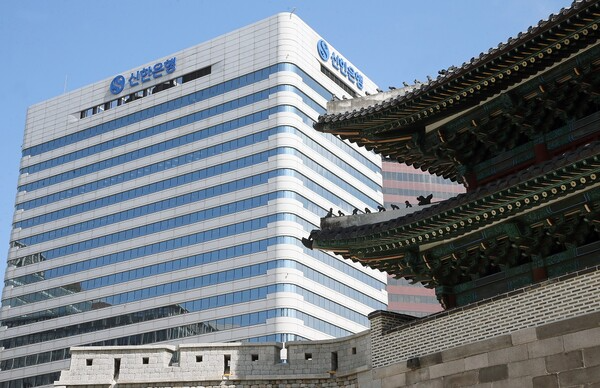 이미지 확대보기
이미지 확대보기According to the “H1 2024 Factbook” released by Shinhan Financial Group(CEO Okdong Jin) on the 8th, which contains management indicators of its affiliates, the share of low-cost deposits in total deposits of Shinhan Bank was 37.7% as of June this year, down 9.7 percentage points (p) from June 2022 (47.4%). In terms of value, the outflow was around KRW 20 trillion, down from KRW 152.2 trillion to KRW 130.5 trillion. This is a decrease of 2.2 %p from the previous quarter (39.9%).
Low-cost deposits, such as occasional deposit accounts with interest rates in the 0% range, are considered key operating assets of banks. To use an analogy from the restaurant industry, it's like using the ingredients needed for cooking for "free." On the other hand, time deposits have the advantage of allowing you to save money for a long period of time, but the disadvantage is the high interest rate. Shinhan Bank's 'Sol convenient Time Deposit' has an interest rate of 2.95 to 3.40% per annum, depending on the subscription period.
As a result, it has become more difficult to raise the net interest margin (NIM), a bank's profit indicator. Shinhan Financial Group interpreted the possibility that its customers will end its long-running high-interest rate trend, including the U.S. Federal Reserve's big cut (a 0.5 percentage point cut in benchmark interest rate) last month.
As the needs (demand) of individual and corporate customers change depending on the interest rate situation, there seems to be a recent trend toward deposits with higher interest rates in preparation for a period of falling interest rates rather than low-cost deposits,” said a Shinhan Bank official.
 이미지 확대보기
이미지 확대보기When interest rates fall, lending rates also come under downward pressure. In this case, an outflow of low-cost deposits and an increase in time deposits will act as upward pressure on the bank's funding rate. This is the case with Shinhan Bank. KB Kookmin Bank, on the other hand, increased its demand deposits, which are low-cost deposits, by 4.5% from KRW 146.5 trillion at the end of 2023 to KRW 153.1 trillion in the first half of this year.
The trend of the loan margin is directly related to the interests of Shinhan Financial shareholders. This has led to speculation that the “Bring-Up & Value-Up Project,” which Shinhan Financial Group launched late last month with the aim of helping savings banks' middle-income customers improve their credit and reduce their financing costs through collaboration among group companies, is a workaround.
The program is a win-win project that converts 'personal credit loans with a principal amount of KRW 50 million or less and a DSR of 70% or less' held by middle credit income salaried customers of Shinhan Savings Bank into new products exclusively for exchange at Shinhan Bank.
It is analyzed that Shinhan Bank will benefit from the transfer of mid-credit customers with less risk of default and earn higher interest rates than the bank's high-credit prime customers. Shinhan Savings Bank is also facing the need to manage its assets through asset reduction as the proportion of non-performing and cautious loans continues to rise. Shinhan has a lot of room to maneuver as its coverage ratio for bad loans reached 1375% as of June this year.
It is also likely to increase its loan-to-deposit ratio. Shinhan Bank's loan-to-deposit ratio was 96.5% as of June this year, which is slightly lower than KB Kookmin Bank's 98.3%.
Han aran(aran@fntimes.com)
[관련기사]
- BOK keeps key rate unchanged for 13th straight session “household debt, US monetary policy direction to be watched”
- Finance Chairman Meets with Bank Chiefs, “DSR Stress Rate for Metropolitan Area Mortgage Loans Raised to 1.2%p“
- Chairman Kim Byung-hwan meets with CEOs from across the financial industry... Household Debt Management & Internal Controls to be Strengthened
가장 핫한 경제 소식! 한국금융신문의 ‘추천뉴스’를 받아보세요~
데일리 금융경제뉴스 Copyright ⓒ 한국금융신문 & FNTIMES.com
저작권법에 의거 상업적 목적의 무단 전재, 복사, 배포 금지







![iM·BNK·JB금융지주, 다양성·전문성 ‘탄탄'…소비자보호 ‘숙제' [금융지주 이사회 점검]](https://cfnimage.commutil.kr/phpwas/restmb_setimgmake.php?pp=006&w=284&h=214&m=5&simg=2025122808195103943dd55077bc2118218214118.jpg&nmt=18)
![정상혁號 신한은행, 정보보호·내부통제 인력 확충 [인사로 본 2026 은행 전략]](https://cfnimage.commutil.kr/phpwas/restmb_setimgmake.php?pp=006&w=284&h=214&m=5&simg=2025122108244903272dd55077bc2118218214118.jpg&nmt=18)
![진옥동 2기 신한금융, 생산적 금융-수익-AX 연계 ‘관건’ [금융권 새 임기 새 과제]](https://cfnimage.commutil.kr/phpwas/restmb_setimgmake.php?pp=006&w=284&h=214&m=5&simg=2025121408345300889dd55077bc25812315162.jpg&nmt=18)
![임종룡號 우리금융 '디노랩', 벤처 190곳 지원…'전세지킴이' 서비스 연계도 [금융권 생산적 중기 육성]](https://cfnimage.commutil.kr/phpwas/restmb_setimgmake.php?pp=006&w=284&h=214&m=5&simg=2025120708452207067dd55077bc221924192119.jpg&nmt=18)

![조용병 은행연합회장 “신뢰·포용·선도 금융으로 경제 재도약 이끌 것” [2026 신년사]](https://cfnimage.commutil.kr/phpwas/restmb_setimgmake.php?pp=006&w=284&h=214&m=5&simg=20251231104524096655e6e69892f222110224119.jpg&nmt=18)
![황병우號 iM금융, 외부영입에 80년대생 전무까지…능력중심·가치경영 확대 [iM금융 2026 임원인사]](https://cfnimage.commutil.kr/phpwas/restmb_setimgmake.php?pp=006&w=284&h=214&m=5&simg=2025111415030600919300bf52dd2121131180157.jpg&nmt=18)
!["비은행 강화 전략 고평가"···임종룡 우리금융회장 연임 성공 [임종룡 우리금융회장 연임]](https://cfnimage.commutil.kr/phpwas/restmb_setimgmake.php?pp=006&w=284&h=214&m=5&simg=2025122918142707908b4a7c6999c21121795134.jpg&nmt=18)
![12개월 최고 연 3.20%…SC제일은행 'e-그린세이브예금' [이주의 은행 예금금리-12월 4주]](https://cfnimage.commutil.kr/phpwas/restmb_setimgmake.php?pp=006&w=110&h=79&m=5&simg=2025122608443302837300bf52dd2121131180157.jpg&nmt=18)
![황병우號 iM금융, 외부영입에 80년대생 전무까지…능력중심·가치경영 확대 [iM금융 2026 임원인사]](https://cfnimage.commutil.kr/phpwas/restmb_setimgmake.php?pp=006&w=110&h=79&m=5&simg=2025111415030600919300bf52dd2121131180157.jpg&nmt=18)
![[프로필] 김성식 예금보험공사 사장 내정자, 30년 경력 법률 전문가](https://cfnimage.commutil.kr/phpwas/restmb_setimgmake.php?pp=006&w=110&h=79&m=5&simg=20251230181747040125e6e69892f5910240225.jpg&nmt=18)
![[프로필] 안석철 KB증권 신임 부사장…신한투자증권 출신 '새얼굴'](https://cfnimage.commutil.kr/phpwas/restmb_setimgmake.php?pp=006&w=110&h=79&m=5&simg=20251229134246021830f4390e77d222110701.jpg&nmt=18)
![[프로필] 김성주 부산은행장 내정자, 은행ㆍIB 두루 거친 '생산적 금융 적임자'](https://cfnimage.commutil.kr/phpwas/restmb_setimgmake.php?pp=006&w=110&h=79&m=5&simg=2025111314424804741dd55077bc212411124362.jpg&nmt=18)